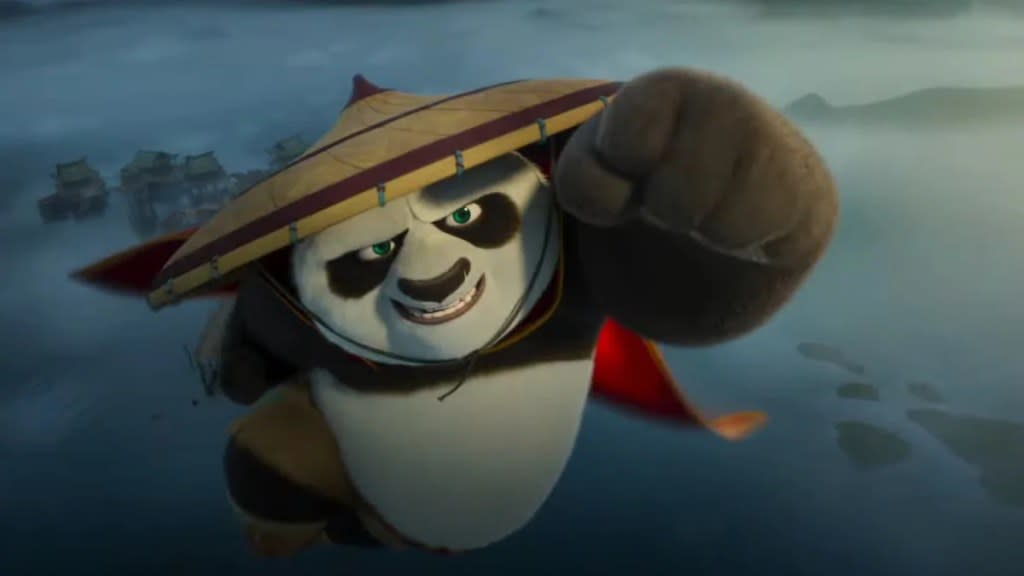‘Kung Fu Panda 4’ Review: New Sequel Lacks the Flavor of Previous Po Adventures

The “Kung Fu Panda” series has, to this point, been one of the crown jewels of DreamWorks Animation’s uneven history. While DreamWorks Animation could never reach the nonstop acclaim that went to Pixar, there were still good films to be found in DWA’s library. The adventures of Po (Jack Black), a clumsy-yet-lovable panda who becomes the fabled Dragon Warrior, managed a balance of comedy and sweetness that set it apart from other animated franchises. Eight years after the last installment, Po is back in “Kung Fu Panda 4,” a sequel that doesn’t necessarily tarnish the franchise, but also shows it was probably best to let sleeping pandas lie.
The watchword of “Kung Fu Panda 4” is “change” despite doing little to stand apart beyond moving the Furious Five, Po’s pals from the previous movies, off on their own adventures (and also saving Universal some coin from having to pay their famous voice actors). As for Po, his mentor Shifu (Dustin Hoffman) informs him that it is time for Po to stop being the Dragon Warrior and pass the mantle to someone else while he assumes the title of spiritual leader for the Valley of Peace.
Po, who loves being the Dragon Warrior, is reluctant to set aside a life of kicking butt and taking names. He also learns his kung fu skills are needed with the rise of The Chameleon (Viola Davis), a villainous shapeshifter who seeks to rule the world. The rascally fox Zhen (Awkwafina) knows how to find The Chameleon, so Po brings the unscrupulous scamp along, and the two start to bond. The film, needing a B plot, enlists Po’s dads, Ping (James Hong) and Li (Bryan Cranston), to follow not far behind as they worry about Po’s safety.
“Kung Fu Panda 4” is a film that constantly feels like it’s grasping for a reason to exist beyond the demands of its parent company. Po learning the importance of change isn’t a bad place to start, but the execution of the story feels gratingly familiar despite the removal of the Furious Five. It’s not so bad that Po must once again learn a lesson and grow, but the emotional core feels largely absent here because the film doesn’t really know if it’s telling Po’s story or Zhen’s.
For example, in the past three movies the villains had some relationship to Po’s world. The Chameleon’s plan to absorb the powers of previous villains only serves to highlight how she has no real relationship to Po or his friends in the Valley of Peace. She’s just a bad guy Po has to face, and one who’s not radically different than General Kai, the villain from “Kung Fu Panda 3” who also harnessed other kung fu masters’ power for his own nefarious ends. That leaves Po fighting some random stranger and his new friend Zhen having more of a connection to The Chameleon than anyone else.
The relationship between Po and Zhen should be the heart of the film, but it never quite comes alive in the way that it needs to because there’s not enough friction between the two characters. Po is too sweet to ever have a serious foil, and Zhen is too roguishly charming to ever feel like much of a threat to Po. You end up getting a buddy comedy that lacks any kind of definition or surprising growth between the two characters beyond Zhen simply repeating the “greatness can come from anywhere” origin story we got with Po in the first movie. You get more comic spark between Ping and Li even though we’re simply waiting for them to catch up to Po so our A plot and B plot can merge.
This mundane approach deflates the entire picture because despite yet another energetic vocal performance from Black, there’s nothing particularly fresh here. Director Mike Mitchell is no stranger to handling sequels to hit animated movies (his past credits include “Shrek Forever After” and “The LEGO Movie 2: The Second Part”), and his presence here feels like one to deliver a product on time rather than a movie that can live up to its predecessors. While the second and third installments raised the bar in how visually stylish these movies could look, there’s hardly anything distinctive in this take on the material. The mandate seems to have been to crank out a reasonable facsimile of a “Kung Fu Panda” movie that can play in theaters before moving to Peacock, but without any thought to the heart and humor that made the previous installments so worthwhile.
Perhaps “Kung Fu Panda 4” will still find success in theaters because it’s a desert out there for parents looking for movies that are appropriate for their young ones (I do not recommend taking your children to “Dune: Part Two” no matter how much they demand to see the Kwisatz Haderach). Perhaps it’s nice for Comcast that they have a “Kung Fu Panda” film that can always live on their streaming service (the first and second installments are currently on Peacock, but the third one is on Netflix). But these movies didn’t sing because they fulfilled a financial obligation. They were lovely movies that looked gorgeous, had a goofy sense of humor, and a good heart.
Like its villain, “Kung Fu Panda 4” can do an imitation, but we can tell it’s not the genuine article.
“Kung Fu Panda 4” will be released exclusively in theaters on March 8.
The post ‘Kung Fu Panda 4’ Review: New Sequel Lacks the Flavor of Previous Po Adventures appeared first on TheWrap.


